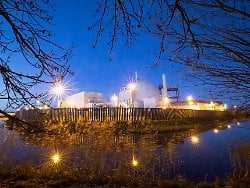Friday December 31, 2021
From the New Year three piles less
Brokdorf nuclear power plant stops producing electricity
Schleswig-Holstein’s last nuclear power plant will finally go offline. On New Year’s Eve, the plant in Brokdorf will feed electricity into the grid for the last time. Two more piles follow suit. The German nuclear phase-out is entering the final phase.
The Brokdorf nuclear power plant last fed electricity into the grid on the last day of the year. According to the nuclear phase-out, the reactor will have to be taken off the grid at the end of the year. This is the end of the era of nuclear power in Schleswig-Holstein. The Krümmel and Brunsbüttel reactors were shut down years ago after serious breakdowns.
According to earlier information from power plant manager Uwe Jorden, the plant is expected to have reached a new record in terms of annual electricity volume in its last year of operation with 11.5 billion kilowatt hours (kWh). The pressurized water reactor with a net output of 1410 megawatts has been in operation since 1986. It produced a good 360 billion kWh.
The Brokdorf nuclear power plant was one of the least susceptible to failure in Germany. At the end of 2017, operator PreussenElektra applied for decommissioning as a consequence of the nuclear phase-out decision. All 193 fuel elements from the reactor core are transferred to a storage pool in January and, after four weeks, to the on-site interim storage facility. The dismantling could take until 2040.
Germany is phasing out nuclear power – right?
Two more piles will go offline by midnight. In addition to Brokdorf, the nuclear power plants in Grohnde, Lower Saxony, and Block C in Gundremmingen, Bavaria, will also be shut down and shut down on New Year’s Eve. However, the legally prescribed demolition will take many years to complete.
In 2022, only three nuclear power plants in Bavaria, Baden-Württemberg and Lower Saxony will supply electricity until production there has to be stopped in exactly one year and the German nuclear phase-out is officially completed. However, two plants that produce fuel and fuel assemblies for export may continue to operate.
The federal government at the time had sealed the phase-out of nuclear energy in 2011 after the nuclear disaster in Fukushima, Japan. Recently, however, more supporters of nuclear energy have expressed themselves again because, unlike electricity production from coal, for example, it creates significantly less climate-damaging carbon dioxide. However, experts see continued operation or new technologies such as small SMR reactors as critical due to a lack of concepts and high construction costs.
